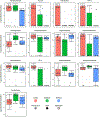Alcohol-induced changes in the gut microbiome and metabolome of rhesus macaques
- PMID: 30903211
- PMCID: PMC6613802
- DOI: 10.1007/s00213-019-05217-z
Alcohol-induced changes in the gut microbiome and metabolome of rhesus macaques
Abstract
Rationale: Increasing evidence has demonstrated that changes in the gut microbiome, including those associated with dietary influences, are associated with alterations in many physiological processes. Alcohol consumption is common across human cultures and is likely to have a major effect on the gut microbiome, but there remains a paucity of information on its effects in primates.
Objectives: The effects of chronic alcohol consumption on the primate gut microbiome and metabolome were studied in rhesus macaques that were freely drinking alcohol. The objectives of the study were to determine what changes occurred in the gut microbiome following long-term exposure to alcohol and if these changes were reversible following a period of abstinence.
Methods: Animals consuming alcohol were compared to age-matched controls without access to alcohol and were studied before and after a period of abstinence. Fecal samples from rhesus macaques were used for 16S rRNA sequencing to profile the gut microbiome and for metabolomic profiling using mass spectrometry.
Results: Alcohol consumption resulted in a loss of alpha-diversity in rhesus macaques, though this was partially ameliorated by a period of abstinence. Higher levels of Firmicutes were observed in alcohol-drinking animals at the expense of a number of other microbial taxa, again normalizing in part with a period of abstinence. Metabolomic changes were primarily associated with differences in glycolysis when animals were consuming alcohol and differences in fatty acids when alcohol-drinking animals became abstinent.
Conclusions: The consumption of alcohol has specific effects on the microbiome and metabolome of rhesus macaques independent of secondary influences. Many of these changes are reversed by a relatively short period of abstinence.
Keywords: Alcohol; Metabolome; Microbiome; Rhesus macaque.
Conflict of interest statement
Conflict of interest
The authors declare that they have no conflicts of interest.
Figures




Similar articles
-
Gut microbiome and metabolome in a non-human primate model of chronic excessive alcohol drinking.Transl Psychiatry. 2021 Dec 1;11(1):609. doi: 10.1038/s41398-021-01728-6. Transl Psychiatry. 2021. PMID: 34853299 Free PMC article.
-
Dietary Gluten-Induced Gut Dysbiosis Is Accompanied by Selective Upregulation of microRNAs with Intestinal Tight Junction and Bacteria-Binding Motifs in Rhesus Macaque Model of Celiac Disease.Nutrients. 2016 Oct 28;8(11):684. doi: 10.3390/nu8110684. Nutrients. 2016. PMID: 27801835 Free PMC article.
-
Taxonomic and Functional Shifts in the Perinatal Gut Microbiome of Rhesus Macaques.Microbiol Spectr. 2022 Aug 31;10(4):e0081422. doi: 10.1128/spectrum.00814-22. Epub 2022 Jul 11. Microbiol Spectr. 2022. PMID: 35863030 Free PMC article.
-
Alcohol response and consumption in adolescent rhesus macaques: life history and genetic influences.Alcohol. 2010 Feb;44(1):67-80. doi: 10.1016/j.alcohol.2009.09.034. Alcohol. 2010. PMID: 20113875 Free PMC article. Review.
-
Ethanol-induced changes to the gut microbiome compromise the intestinal homeostasis: a review.Gut Microbes. 2024 Jan-Dec;16(1):2393272. doi: 10.1080/19490976.2024.2393272. Epub 2024 Sep 3. Gut Microbes. 2024. PMID: 39224006 Free PMC article. Review.
Cited by
-
The human gut bacteria Christensenellaceae are widespread, heritable, and associated with health.BMC Biol. 2019 Oct 28;17(1):83. doi: 10.1186/s12915-019-0699-4. BMC Biol. 2019. PMID: 31660948 Free PMC article. Review.
-
The Microbiome-Gut-Brain Axis, a Potential Therapeutic Target for Substance-Related Disorders.Front Microbiol. 2021 Oct 6;12:738401. doi: 10.3389/fmicb.2021.738401. eCollection 2021. Front Microbiol. 2021. PMID: 34690981 Free PMC article. Review.
-
Gut microbial diversity and functional characterization in people with alcohol use disorder: A case-control study.PLoS One. 2024 Jun 12;19(6):e0302195. doi: 10.1371/journal.pone.0302195. eCollection 2024. PLoS One. 2024. PMID: 38865325 Free PMC article.
-
Alcohol as friend or foe in autoimmune diseases: a role for gut microbiome?Gut Microbes. 2021 Jan-Dec;13(1):1916278. doi: 10.1080/19490976.2021.1916278. Gut Microbes. 2021. PMID: 34224314 Free PMC article. Review.
-
Ramen Consumption and Gut Microbiota Diversity in Japanese Women: Cross-Sectional Data from the NEXIS Cohort Study.Microorganisms. 2023 Jul 26;11(8):1892. doi: 10.3390/microorganisms11081892. Microorganisms. 2023. PMID: 37630452 Free PMC article.
References
-
- Boschloo L, Vogelzangs N, Smit JH, van den Brink W, Veltman DJ, Beekman AT, Penninx BW (2011) Comorbidity and risk indicators for alcohol use disorders among persons with anxiety and/or depressive disorders: findings from the Netherlands Study of Depression and Anxiety (NESDA) Journal of affective disorders 131:233–242 doi:10.1016/j.jad.2010.12.014 - DOI - PubMed
MeSH terms
Substances
Grants and funding
LinkOut - more resources
Full Text Sources
Medical

